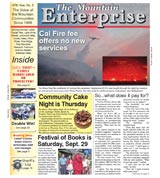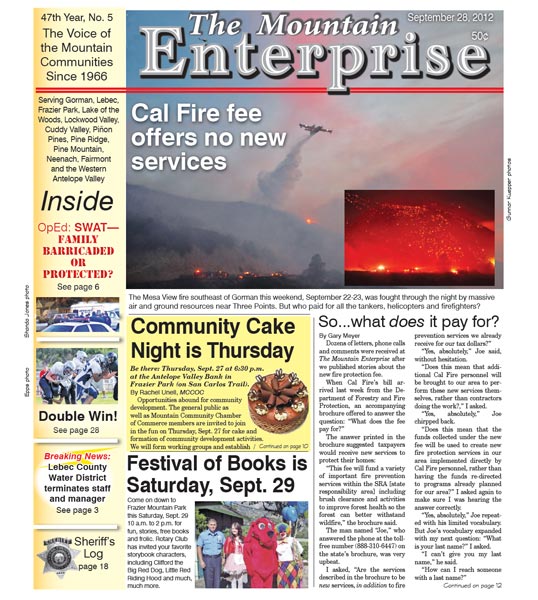By Gary Meyer
Dozens of letters, phone calls and comments were received at The Mountain Enterprise after we published stories about the new fire protection fee.
When Cal Fire’s bill arrived last week from the Department of Forestry and Fire Protection, an accompanying brochure offered to answer the question: “What does the fee pay for?”
The answer printed in the brochure suggested taxpayers would receive new services to protect their homes:
“This fee will fund a variety of important fire prevention services within the SRA [state responsibility area] including brush clearance and activities to improve forest health so the forest can better withstand wildfire,” the brochure said.
The man named “Joe,” who answered the phone at the tollfree number (888-310-6447) on the state’s brochure, was very upbeat.
I asked, “Are the services described in the brochure to be new services, in addition to fire prevention services we already receive for our tax dollars?”
“Yes, absolutely,” Joe said, without hesitation.
“Does this mean that additional Cal Fire personnel will be brought to our area to perform these new services themselves, rather than contractors doing the work?,” I asked.
“Yes, absolutely,” Joe chirpped back.
“Does this mean that the funds collected under the new fee will be used to create new fire protection services in our area implemented directly by Cal Fire personnel, rather than having the funds re-directed to programs already planned for our area?” I asked again to make sure I was hearing the answer correctly.
“Yes, absolutely,” Joe repeated with his limited vocabulary. But Joe’s vocabulary expanded with my next question: “What is your last name?” I asked.
“I can’t give you my last name,” he said.
“How can I reach someone with a last name?”
Joe gave me a number to call the southern region office for Cal Fire, where I reached the coordinator for the southern region, Jim McDougal. He referred me to Cal Fire Public Information Officer Daniel Berlant. Berlant’s vocabulary was more extensive and revealed that everything I was told by “Joe” at the toll-free number was untrue.
In answer to the same question, Berlant replied bluntly, “No, these are not new services. The money goes into a special fund at the state level and can only be spent for fire prevention. Cal Fire’s budget is funded through the state’s general fund,” he said. “Some of the services mentioned in the brochure are contracted by Kern County and Los Angeles County in your area.”
“The fee covers only fire prevention… not fire fighting?” I asked.
“That’s correct, no fire fighting activities or [equipment].”
In the Mountain Communities, most of the hazard reduction has been done through federal grants obtained by the local Fire Safe Council, so the lack of new service was clear. Homeowners have also cleared their lots at their own expense.
Kern County Fire Chief Brian Marshall confirmed that his department is Cal Fire’s representative in Kern County and his crews provide the fire protection services in the State Responsibility Area (SRA) on behalf of Cal Fire.
“To have a Cal Fire station in the Frazier Park area would be a waste of taxpayers’ money,” Marshall said. He explained that this is why they contract with the county agencies—it saves money and is more efficient, in his view.
“Many people aren’t aware that the state and federal agencies have exchanged lands,” Marshall said. [He means exchanged responsibilities for fire protection of lands, not ownership.] “So, while local areas like Cuddy Valley and Pine Mountain Club are in the state SRA, the protection has been taken by the U.S. Forest Service, even though it’s the state’s responsibility area,” Marshall explained.
“If we have a fire in the forest, I’ll still respond to it, but I only send part of my resources, and BLM will send part, and forest service will send part. This way, if there are additional incidents somewhere, we’ve got resources back at the station that can respond,” he said.
When asked if the SRA maps provided by the state would reflect the protection responsibility exchanges, he said, “The maps probably show the ownership and probably don’t show the exchanges.”
In the conversations with Cal Fire’s Berlant and Kern County’s Chief Marshall, it became clear that when our local agencies are seen responding to fires, there are numerous agreements operating in the background. Agencies pay for services provided by another agency, but billing and payment do not necessarily kick in on all incidents.
“The agencies cooperate with one another and billing often doesn’t occur unless an incident reaches a certain level,” Marshall said. If an incident goes from a couple of days to a week with air tankers brought in, then billing would be issued from one agency to another, he said.
Observers have noted that fire fighting this year has been far more aggressive in our area than in the past, with hundreds of firefighters dispatched, for instance, to the Mesa View fire southeast of Gorman this past weekend. There were two air tankers, two super-scoopers, five helicopters and over 300 firefighters working on the fire that was contained at about 25 acres.
Most of the wildland fires we have reported on adjacent to the Mountain Communities in Kern County this year have had helicopters and often fixed wing tankers called in almost immediately to contain the fires as rapidly as possible.
Cal Fire has effectively lost about $160 million to budget cuts and accounting maneuvers over the last 18 months. The new SRA fee is projected to bring in about $88 million per year to state coffers, Berlant said.
While it’s true that taxpayers are already paying for fire protection, it is also true that a nationwide economic crisis has made California’s economic problems more severe over the last four years. The $88 million is money Cal Fire officials say they need to pay contractors for prevention of fire to protect homes and lives.
The fee is about $115 for most homeowners in our region. Penalties and interest are promised for failure to pay the fee by October 15, which could also result in a lien against your property. You may write “paid under protest” in the memo field of your check.
Protests with your name, mailing address and address of the property can be sent to:
- Special Taxes Remittance Processing, State Board of Equalization, P.O. Box 942879, Sacramento, CA 94279
- Fire Prevention Fee Service Center, Attn: Petitions, P.O. Box 2254, Suisun City, CA 94585
- Board of Forestry and Fire Protection, P.O. Box 944246, Sacramento, CA 94244
See www.MountainEnteprise.com at Community FYI for a sample letter of protest.
This is part of the September 28, 2012 online edition of The Mountain Enterprise.
Have an opinion on this matter? We'd like to hear from you.


